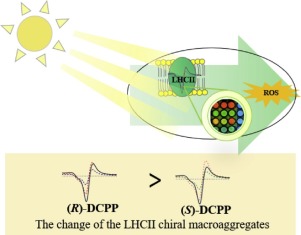Aquatic Toxicology ( IF 4.5 ) Pub Date : 2018-11-06 , DOI: 10.1016/j.aquatox.2018.11.003 Hui Chen , Chensi Shen , Zunwei Chen , Babar Aijaz Ali , Yuezhong Wen

|
The enantioselective toxic mechanisms of chiral herbicides in photosynthetic organisms are closely related to the production of reactive oxygen species (ROS) production, however, there are few reports on how the enantioselective production of ROS can be triggered. In suboptimal conditions, photosynthesis is one of the most important processes in the production of ROS, especially in the process of light utilization and electron transfer. In this study, we investigated the interactions between chiral herbicide dichlorprop (DCPP) enantiomers and the chiral macroaggregates of the photosynthetic light-harvesting chlorophyll a/b pigment-protein complexes (LHCII) in Scenedesmus obliquus, which is of great significance in capturing and utilizing sun light, and also in dissipating the excess excitation energy. The results of the circular dichroism indicated that DCPP induced the structural changes of the LHCII chiral macroaggregates in an enantioselective manner and that the (R)-DCPP treated-group showed a bigger change accompanied by a changed enantioselective dissipation of the excitation energy. The excitation energy was excessed in DCPP treated-groups and the degree of excess was enantioselective and the detrimental non-chemical energy triggered the enantioselective production of ROS, that induced the enantioselective toxicity to green algae S. obliquus. Overall, this study has identified that how the enantioselective production of ROS can be triggered in chloroplasts; this can help to reveal the enantioselective mechanisms of chiral herbicides to photosynthetic organisms.
中文翻译:

敌敌畏对LHCⅡ手性大分子聚集体的结构变化与对斜枝线虫的对映选择性毒性有关
光合生物中手性除草剂的对映选择性毒性机制与活性氧(ROS)的产生密切相关,但是,关于如何触发ROS的对映选择性的报道很少。在次优条件下,光合作用是ROS生产中最重要的过程之一,尤其是在光利用和电子转移过程中。在这项研究中,我们调查了手性除草剂双氯丙二酸(DCPP)对映异构体与斜叶Scenedesmus obliquus中光合光捕获光合作用的叶绿素a / b色素-蛋白质复合物(LHCII)的手性大聚集体之间的相互作用。,这对于捕获和利用太阳光以及消散多余的激发能量具有重要意义。圆二色性的结果表明,DCPP以对映选择性的方式诱导了LHCII手性大聚集体的结构变化,并且(R)-DCPP处理组显示出更大的变化,伴随着激发能的对映选择性消散的改变。DCPP处理组中的激发能过量,过量的程度是对映选择性的,有害的非化学能触发了ROS的对映选择性的产生,从而诱导了对绿藻S. obliquus的对映选择性毒性。。总体而言,这项研究已经确定了如何在叶绿体中触发ROS的对映选择性产生。这可以帮助揭示手性除草剂对光合生物的对映选择性机制。


























 京公网安备 11010802027423号
京公网安备 11010802027423号